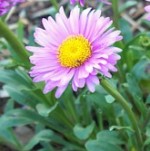 Alpine aster is a shot-lived herbaceous perennial native to Canada, US, and the mountains of Europe including the Alps and the Pyrenees. It is a member of the Asteraceae family that also includes daisies, sunflowers, and lettuce. The plant forms a basal clump of narrow 1 ½ to 2 inch long leaves that are gray-green in the spring but turn dark green in the summer. The daisy-like flowerheads are one to three inches across and have violet blue ray flowers surrounding yellow disc flowers. Each solitary flowerhead is carried on a sturdy stem clothed with a few sessile leaves from late spring to summer. Cultivars are available with pink, dark purple-black, near white, and blue flowerheads. A good choice for rockgardens. The genus name Aster comes from the Latin word aster meaning star and refers to the shape of the flower. The specific epithet alpinus comes from the Latin word meaning of the alps, referring to the mountainous habitat of the plant.
Alpine aster is a shot-lived herbaceous perennial native to Canada, US, and the mountains of Europe including the Alps and the Pyrenees. It is a member of the Asteraceae family that also includes daisies, sunflowers, and lettuce. The plant forms a basal clump of narrow 1 ½ to 2 inch long leaves that are gray-green in the spring but turn dark green in the summer. The daisy-like flowerheads are one to three inches across and have violet blue ray flowers surrounding yellow disc flowers. Each solitary flowerhead is carried on a sturdy stem clothed with a few sessile leaves from late spring to summer. Cultivars are available with pink, dark purple-black, near white, and blue flowerheads. A good choice for rockgardens. The genus name Aster comes from the Latin word aster meaning star and refers to the shape of the flower. The specific epithet alpinus comes from the Latin word meaning of the alps, referring to the mountainous habitat of the plant.
Type: Herbaceous perennial
Bloom: Soliary, daisy-like flowerheads 1 to 3 inches across with violet blue ray flowers surrounding yellow disc flowers from late spring into summer.
Size: 6-9” H x 12” W
Light: Full sun
Soil: Average, medium moist, well-drained
Hardiness: Zones 4-7
Care: Deadhead to promote bloom; divide every three to our years to promote longevity
Pests and Diseases: Slugs, snails, aphids, eelworms, wilt, leaf spot, mildew
Propagation: Seed, division in spring
Companion Plants:Diascia, black eyed Susan, ornamental grasses such as Fescue, Aubrieta
Outstanding Selections:
‘Albus; (white flowers)
‘Dark Beauty’ (deep violet blue flowers)
‘Happy End’ (rose pink flowers)
‘Goliath’ (larger flowers, 2 ½ -3 “ diameter)
’Wargrave Variety’ (pale pink flowers)